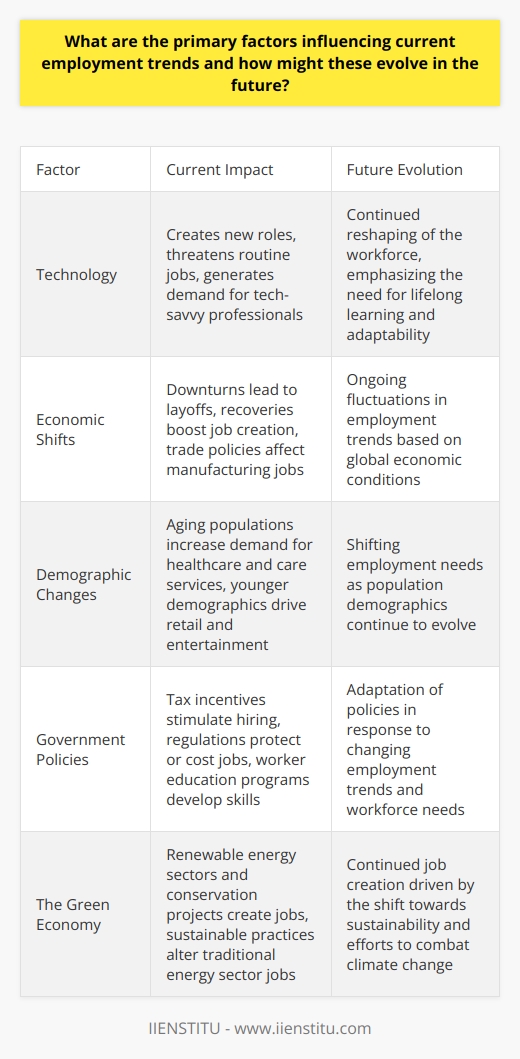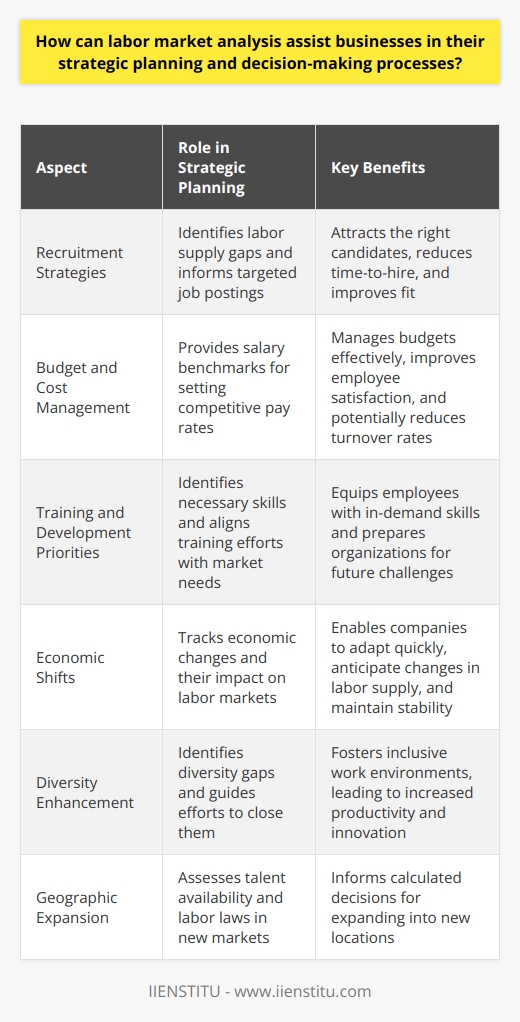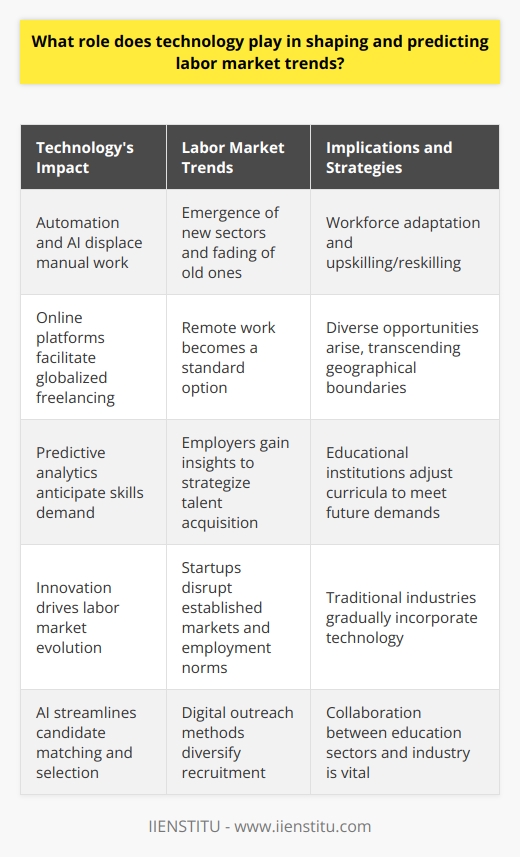In an ever-evolving economic landscape, the ability to examine and interpret employment trends through labor market analysis remains a pivotal skill for policymakers, businesses, and individuals alike. This analytical process aids stakeholders in understanding various facet of employment, from job creation to wage patterns within a specific geographic or industry sector.
As we delve into the nuances of labor market analysis, it is essential to recognize its capacity to guide informed decisions and anticipate future shifts in the job market. Herein we shall explore the sophisticated world of labor market analysis, its methodologies, implications, and practical value to various levels of economic participants.
Understanding Labor Market Analysis
Labor market analysis is an invaluable tool that provides insights into the complexities of the employment sector. By examining the interplay between the supply (workers) and demand (jobs) within the labor force, experts can draw significant conclusions about the economic well-being of a region or sector.
Definition of Labor Market Analysis
Labor market analysis is a multifaceted approach to understanding employment trends within a particular geography or industry. This analysis encompasses a wide range of data points, including employment rates, skill requirements, wage levels, and employer demands.
Key elements of labor market analysis involve dissecting these data sets to ascertain how various sectors are performing, where job growth is occurring, and what skills are necessary for the evolving workforce.
Purpose and Objectives of Labor Market Analysis
Fundamentally, the purpose of labor market analysis is to achieve a prosperous balance between labor supply and demand. Its objectives are tailored to provide a granular understanding of the workforce and economic environment. Specifically, identifying trends and changes in the labor market enables stakeholders, from government entities to educational institutions, to align their strategies with market realities, ensuring better outcomes for job-seekers and employers alike.
Application of Labor Market Analysis in various sectors
Labor market analysis applies across all sectors of the economy. In retail, for example, analysis might reveal an increasing demand for e-commerce professionals due to the shift from in-store shopping to online.
Conversely, in manufacturing, labor market analysis might indicate a growing need for automation technicians as companies incorporate more robotics into their processes. These examples underscore the practical relevance of labor market analysis, informing decisions about training programs, recruitment strategies, and investment opportunities.
Steps in Conducting Labor Market Analysis
A systematic approach to labor market analysis enables stakeholders to craft strategic decisions rooted in empirical data. This process involves several critical steps, from identifying the specific market to collecting and scrutinizing relevant data.
Identification of Labor Market
The foundation of labor market analysis is establishing the boundaries of the market under review. This can be determined by geographical boundaries, such as a city, region, or country, or by occupational or industry boundaries, focusing on specific sectors like technology, healthcare, or finance. Defining the scope of the labor market is crucial to targeting analysis effectively.
Gathering and Analyzing Labor Market Information
Once the market is defined, the next step is to collect pertinent information. Primary data might come directly from surveys and interviews, offering fresh and specific insights, whereas secondary data could involve existing research, reports, and statistics from government or academic sources. Together, these data streams form a comprehensive picture of the labor market landscape.
Understanding Labor Market Indicators
Labor market indicators are key statistics that provide a snapshot of economic performance. These include metrics such as the unemployment rate, job vacancy rates, and median earnings. Understanding these indicators and their significance enables a thorough comprehension of market conditions, including the identification of trends that can profoundly impact employment prospects.
Benefits and Limitations of Labor Market Analysis
The insights derived from labor market analysis can be transformative for numerous stakeholders when utilized effectively. However, these benefits are often constrained by inherent limitations within the process.
Benefits of Labor Market Analysis
In terms of benefits, labor market analysis can inform policy-making, ensuring that labor regulations and economic strategies are based on current industry needs. Furthermore, it supports facilitating career decision-making among job-seekers, guiding them to in-demand roles that match their skill set. For businesses, it plays a critical role in enhancing recruitment and retention strategies, enabling employers to attract and maintain a competent workforce.
Limitations of Labor Market Analysis
Despite these advantages, labor market analysis also encounters challenges. At times, there may be limitations in data, such as outdated information or incomplete data sets. Additionally, the complexities of labor market dynamics mean that swift changes in technology, globalization, and economic forces can quickly render previous analysis less relevant.
Predicting future labor trends is an ongoing challenge as it involves extrapolating from current data and trends which may not always capture emerging changes.
Case Study: A Successful Labor Market Analysis
Even with complexities and limitations, labor market analysis can result in significant strategic success for organizations. A well-documented case study will illustrate the concrete benefits of this analytical process.
Description of the Company
Consider a mid-sized technology firm seeking to expand its product offerings. With a well-established base in software development, the company is eyeing the burgeon cloud services market.
The Need for Labor Market Analysis
To understand the labor needs for this strategic pivot, the company recognizes the necessity of a thorough labor market analysis to guide its hiring and training initiatives.
The Process Undertaken for the Analysis
The analysis commenced with a comprehensive review of the current labor force, required skill sets, and projections for future demand within the cloud services sector.
Key Findings and How They Were Used
The company discovered a significant demand for security and infrastructure specialists able to manage large-scale cloud deployments. It then utilized these findings to develop tailored online certification courses and recruit personnel with these specific competencies.
Outcome and Impacts
The focused approach facilitated by labor market analysis allowed the company to effectively reallocate resources, leading to a successful market entry and increased profitability.
In summary, labor market analysis serves as a critical barometer for the health and direction of employment sectors. Its efficacy in shaping effective strategies for workforce development, economic policy, and business operations cannot be overstated. As today's world becomes more dynamic and technologically driven, the importance of labor market analysis only grows, prompting a continued need for its application and refinement.
Consequently, it is essential that individuals and organizations alike stay abreast of labor market trends, seeking further education through avenues like human resources course to maintain and enhance their analytic capabilities. Regardless of one's role in the economy, a firm grasp of labor market analysis promises a more informed and strategic approach to the future of work.








